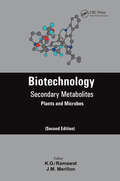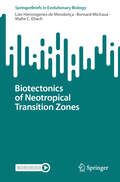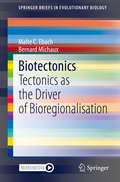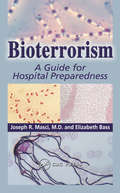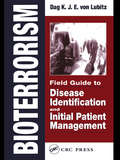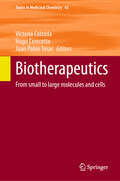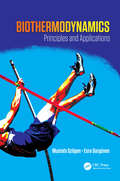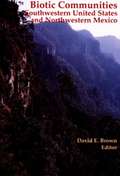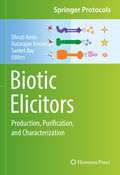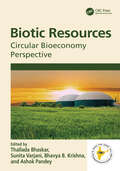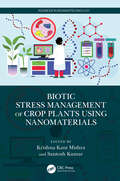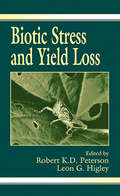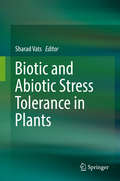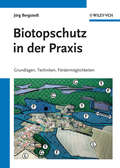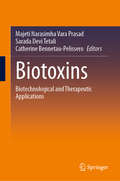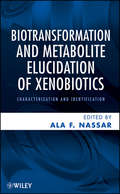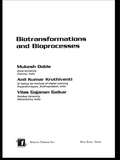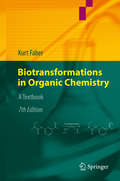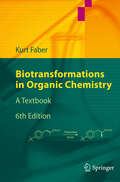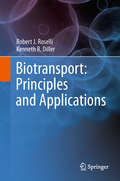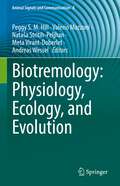- Table View
- List View
Biotechnology: Secondary Metabolites
by K.G. RamawatThis book provides new information relating recent advances made in the field of plant secondary products. Besides the updation of chapters this edition also includes chapters on secondary metabolites of microorganisms (fungi and lichen).
Biotectonics of Neotropical Transition Zones (SpringerBriefs in Evolutionary Biology)
by Malte C. Ebach Bernard Michaux Lize Hermógenes de MendonçaThis book offers an up-to-date review and synthesis of the role of tectonics in Neotropical bioregionalisation, in particular transition zones. The main questions are "What are transition zones?", "How would we identify them?" and, "What are the tectonic drivers of transition zones?" These questions are pertinent as they may reveal a new transition zone within the Caribbean (Antillean sub-region), and provides an up-to-date account of the biotectonics of the Caribbean. In addition, the book contains a detailed tectonic summary of the development of the Andes and the bioregionalisation of the South American Transition Zone.
Biotectonics: Tectonics as the Driver of Bioregionalisation (SpringerBriefs in Evolutionary Biology)
by Malte C. Ebach Bernard MichauxTectonic plates are constantly moving, either crashing into one another creating a mosaic of mountains and shallow seas, or tearing apart and isolating large swathes of land. In both cases plate tectonics separates populations leading to the evolution of biota. Tectonics is also responsible for the destruction life, for instance when large coral reefs or shallow seas are compressed to form mountain peaks. Could recent research into these processes provide enough evidence to show that tectonics may be the ultimate driver of life on Earth? Our book delves into the current research in tectonics, particularly neotectonics, and its impact on rapid changes on biogeographical classification, also known as bioregionalisation. We also introduce a new term biotectonics that studies the impact of tectonics on biogeoregionalisation. The question we ask is how tectonics directly influences the distribution of biota in four case studies: the Mesozic and early Palaeogene Australides, which spans the Proto-Pacific coast of the South America, Antaractica and Australiasia; and the Neogene of Australia. To conclude we examine the role of neotectonics on tranistion zones and the Amazon Basin and make a case for biotectonic extinction.
Bioterror and Biowarfare: A Beginner's Guide (Beginner's Guides)
by Malcolm DandoIn this essential guide to the past, present and future of bio-warfare, international security expert Malcolm Dando draws a wealth of experience and research to uncover the truth about the alarming failure of international community to place effective curbs on the use of this deadly weapon.
Bioterrorism and Infectious Agents: A New Dilemma for the 21st Century (Emerging Infectious Diseases of the 21st Century)
by Kenneth Alibek I. W. FongCompiled by two leading experts in the field, this volume provides a concise, timely, and authoritative review of some of the most problematic infections of the new century. It presents issues and new ideas for preventing and controlling infectious diseases.
Bioterrorism: A Guide for Hospital Preparedness
by Elizabeth Bass Joseph R. Masci M.D.In the battle against bioterrorism, one of the greatest challenges is finding the ideal balance between complacency and overreaction. The goal is to be so well prepared that we can prevent catastrophic outcomes in the event of a bioterrorist attack, while strengthening our ability to prevent and treat naturally-occurring infectious diseases.Bioterr
Bioterrorism: Field Guide to Disease Identification and Initial Patient Management
by Dag K.J.E. von LubitzThe outbreak of anthrax infections that followed September 11, 2001, showed all too clearly that while we can defend ourselves against bioterrorism, our defenses need improvement. What's most important is the ability to recognize the associated disease, and recognize them quickly. Yet, many in the medical world are unfamiliar with the characteristi
Biotherapeutics: From small to large molecules and cells (Topics in Medicinal Chemistry #42)
by Victoria Calzada Hugo Cerecetto Juan Pablo TosarThis book reviews biotherapeutics from a medicinal chemistry perspective. It covers proteins, nucleic acids, low molecular weight hormones, small peptides, extracellular vesicles, gene therapy, cell-based products, and tissue-engineered products. Expert contributors provide insights into the mechanisms of action and translational processes of biotherapeutics. Particular attention is given to the latest developments in therapeutic proteins and nucleic acids. Biotherapeutic formulation developments like encapsulation, structural modifications and nanovehiculization are also presented in this book. Divided into 15 chapters, the book begins with basic concepts and definitions of biotherapeutics from a medicinal chemistry standpoint. The following chapters focus on therapeutic proteins, monoclonal antibodies, protein production, and structural modifications. Other chapters cover topics such as antisense oligonucleotides, aptamers, mRNA, gene therapy, as well as other biotherapeutics like low molecular weight hormones and small peptides. The book concludes with an overview of biotherapeutic formulations and an authoritative discussion on regulatory aspects. Throughout the book, readers will learn how biotherapeutics, whether obtained through bioprocesses or not, impact bioresponses and can be utilized for therapeutic purposes. Given its breadth, the book appeals to researchers in medicinal chemistry and biotherapeutics, scholars of medicinal chemistry, students at all levels of biochemical studies, practitioners in the medical field, and anyone interested in biotherapeutics.
Biothermodynamics: Principles and Applications
by Mustafa Ozilgen Esra Sorguven OnerOver the past several decades there has been increasing research interest in thermodynamics as applied to biological systems. This concerns topics such as muscle work and internal energy such as fat and starch. Applications of the first and second laws of thermodynamics to the human body are important to dieticians and health science experts, and applications of these concepts to the animal body are a major concern of animal scientists. This book covers these key topics, which are typically not covered in classic or traditional thermodynamics texts used in mechanical and chemical engineering.
Biotic Communities: Southwestern United States and Northwestern Mexico
by David BrownellBiotic Communities catalogs and defines by biome, or biotic community, the region centered on Arizona, New Mexico, Sonora, Chihuahua, and Baja California Norte, plus portions of California, Nevada, Utah, Colorado, Texas, Coahuila, Sinaloa, and Baja California Sur. This ambitious guide is an essential companion for anyone working in natural resources management and ecological research, as well as nonspecialists looking for solid information about a particular southwestern locale. Biotic Communities is arranged by climatic formation with a short chapter for each biome describing climate, physiognomy, distribution, dominant and common plant species, and characteristic vertebrates. Subsequent chapters contain careful descriptions of zonal subdivisions.
Biotic Elicitors: Production, Purification, and Characterization (Springer Protocols Handbooks)
by Natarajan Amaresan Dhruti Amin Sanket RayThis volume details techniques to study biotic elicitors involved in the field of agriculture for the benefit of the environment and growers. Chapters guide readers through protein, carbohydrate, lipid, glycoprotein and glycolipid components derived from microorganisms and their production, purification, and characterization. Authoritative and cutting-edge, Biotic Elicitors: Production, Purification, and Characterization serve as an essential resource for researchers in agricultural microbiology, plant biotechnology, and plant pathology. @font-face {font-family:"Cambria Math"; panose-1:2 4 5 3 5 4 6 3 2 4; mso-font-charset:0; mso-generic-font-family:roman; mso-font-pitch:variable; mso-font-signature:-536870145 1107305727 0 0 415 0;}@font-face {font-family:Calibri; panose-1:2 15 5 2 2 2 4 3 2 4; mso-font-charset:0; mso-generic-font-family:swiss; mso-font-pitch:variable; mso-font-signature:-536858881 -1073732485 9 0 511 0;}p.MsoNormal, li.MsoNormal, div.MsoNormal {mso-style-unhide:no; mso-style-qformat:yes; mso-style-parent:""; margin-top:0cm; margin-right:0cm; margin-bottom:8.0pt; margin-left:0cm; line-height:107%; mso-pagination:widow-orphan; font-size:11.0pt; font-family:"Calibri",sans-serif; mso-ascii-font-family:Calibri; mso-ascii-theme-font:minor-latin; mso-fareast-font-family:Calibri; mso-fareast-theme-font:minor-latin; mso-hansi-font-family:Calibri; mso-hansi-theme-font:minor-latin; mso-bidi-font-family:"Times New Roman"; mso-bidi-theme-font:minor-bidi; mso-fareast-language:EN-US;}.MsoChpDefault {mso-style-type:export-only; mso-default-props:yes; font-size:11.0pt; mso-ansi-font-size:11.0pt; mso-bidi-font-size:11.0pt; font-family:"Calibri",sans-serif; mso-ascii-font-family:Calibri; mso-ascii-theme-font:minor-latin; mso-fareast-font-family:Calibri; mso-fareast-theme-font:minor-latin; mso-hansi-font-family:Calibri; mso-hansi-theme-font:minor-latin; mso-bidi-font-family:"Times New Roman"; mso-bidi-theme-font:minor-bidi; mso-fareast-language:EN-US;}.MsoPapDefault {mso-style-type:export-only; margin-bottom:8.0pt; line-height:107%;}div.WordSection1 {page:WordSection1;}
Biotic Evolution and Environmental Change in Southeast Asia
by David J. Gower Kenneth G. Johnson James E. Richardson Brian R. Rosen Lukas Rüber Suzanne T. Williams David J. Gower Kenneth G. Johnson James E. Richardson Brian R. Rosen Lukas RüberThe flora and fauna of Southeast Asia are exceptionally diverse. The region includes several terrestrial biodiversity hotspots and is the principal global hotspot for marine diversity, but it also faces the most intense challenges of the current global biodiversity crisis. Providing reviews, syntheses and results of the latest research into Southeast Asian earth and organismal history, this book investigates the history, present and future of the fauna and flora of this bio- and geodiverse region. Leading authorities in the field explore key topics including palaeogeography, palaeoclimatology, biogeography, population genetics and conservation biology, illustrating research approaches and themes with spatially, taxonomically and methodologically focused case studies. The volume also presents methodological advances in population genetics and historical biogeography. Exploring the fascinating environmental and biotic histories of Southeast Asia, this is an ideal resource for graduate students and researchers as well as environmental NGOs.
Biotic Resources: Circular Bioeconomy Perspective
by Ashok Pandey Sunita Varjani Thallada Bhaskar Bhavya B. KrishnaThis reference book provides advanced knowledge on sustainable biogenic waste management. It covers innovative waste processing technologies to produce biofuels, energy products, and biochemicals. To create a circular bioeconomy, it is imperative to develop processes where the waste generated through one process acts as a feedstock for the other. This book discusses the latest developments in biochemical and thermochemical methods of conversion and covers the potential of different kinds of biomass in more decentralized biorefineries. It describes sustainable solutions for a greener supplement to fossil resources. The book is meant for microbiologists, chemists, and biotechnologists.
Biotic Stress Management of Crop Plants using Nanomaterials (Advances in Bionanotechnology)
by Santosh Kumar Krishna Kant MishraThis book summarizes nanotechnology-based agricultural research for crop productivity and the management of various plant pathogens. It deals with the application of nano-molecules for quick, cost-effective, and precise plant disease diagnostic procedures, plant pests and disease management, nano-pesticides, and nano-diagnostics. Further, it explains nanomaterials for biotic stress management, with an insight into the synthesis and modification of nanomaterials and their potential applications in different domains for disease management. Features include: Compilation of current research on the Nanomaterials as well as their versatile applications in plant biotic stress management Description of the role of nanomaterials as enzyme-mimicking nanoparticles, nano-pesticides, nano-fertilizers, and nanomaterials Review of day-to-day problems related to crop plants, their diagnostics, and stress management Exploration of trends in nanomaterial utility in diagnostics, enzyme-mimicking, and crop protection, and their possible role in plant disease management Study of pertinent nanomaterials including synthetic strategies, properties, chemistry, and applications This book is aimed at researchers and graduate students in plant pathology, genetic engineering, environmental science, botany, bioengineering, and nanotechnology.
Biotic Stress and Yield Loss
by Robert K.D. Peterson Leon G. HigleyUnderstanding biotic stress and plant yield allows for the practical development of economic decision making, an instrumental part of Integrated Pest Management. And further, the impact of biotic injury on plant yield bears directly on the basic biological questions of population dynamics, life history strategies, community structure, plant-stresso
Biotic Type Antioxidants: the prospective search area for novel chemical drugs
by E A. ParfenovThe discovery of molecular and cellular mechanisms of pathology, together with the present data on drug treatment result in enhanced drug design and testing. The known mechanisms of biological activity as displayed by ascorbic acid and other natural reductones are the reason that they are considered to be physiologically compatible antioxidants, many of which are trace elements in food. The pharmacological potential of natural antioxidants may be enhanced by chemical modification. Biotic antioxidants possess an important potential to be a reliable basis of the development of new multipurpose drugs, within the framework of existing technological structures. This book shows approaches for possible use of these natural antioxidants. In particular, such an approach is described for the case of the design of superoxide dismutase models with anti-tumour activity.
Biotic and Abiotic Stress Tolerance in Plants
by Sharad VatsThis book highlights some of the most important biochemical, physiological and molecular aspects of plant stress, together with the latest updates. It is divided into 14 chapters, written by eminent experts from around the globe and highlighting the effects of plant stress (biotic and abiotic) on the photosynthetic apparatus, metabolites, programmed cell death, germination etc. In turn, the role of beneficial elements, glutathione-S-transferase, phosphite and nitric oxide in the adaptive response of plants under stress and as a stimulator of better plant performance is also discussed. A dedicated chapter addresses research advances in connection with Capsicum, a commercially important plant, and stress tolerance, from classical breeding to the recent use of large-scale transcriptome and genome sequencing technologies. The book also explores the significance of the liliputians of the plant kingdom (Bryophytes) as biomonitors/bioindicators, and general and specialized bioinformatics resources that can benefit anyone working in the field of plant stress biology. Given the information compiled here, the book will offer a valuable guide for students and researchers of plant molecular biology and stress physiology alike.
Biotopschutz in der Praxis: Grundlagen -Techniken - Fordermoglichkeiten - Grundlagen - Planung - Handlungsmöglichkeiten
by Jörg BergstedtWer Biotope wirksam schützen will, muss deren Funktion verstehen. Auch wenn der der hohe Wert von natürlichen Lebensräumen für das ökologische Gleichgewicht der Erde lange bekannt ist, hat es die Natur nach wie vor schwer, sich angesichts des immer größeren Flächenverbrauchs durch den Menschen zu behaupten. Doch mit dem richtigen Handwerkszeug können intakte Biotope selbst dort entstehen, wo man sie kaum vermutet: am Rande von intensiv genutzten Ackerflächen, auf Abraumhalden oder mitten in der Großstadt. Dieser Ratgeber enthält das nötige Hintergrundwissen für den Schutz und die Neuanlage von Biotopen. Er zeigt, worauf es wirklich ankommt - von den ökologischen Grundlagen bis hin zu konkreten Schutzmaßnahmen und bestehenden Fördermöglichkeiten. Rund 30 der wichtigsten Lebensräume werden vorgestellt und ihre Bedeutung für das ökologische Landschaftsgefüge erklärt. Zahlreiche Schemata und Beispielbilder veranschaulichen die konkreten Maßnahmen für den praktischen Biotopschutz, ohne die Komplexität der Ökosysteme dabei auszublenden. Alles was man zum Schutz und bei der Neuanlage von Biotopen wissen muss. Ideal für Unterricht, Jugendarbeit und für alle Praktiker im Biotopschutz. Weiteres Material finden Sie unter www.biotopschutz.de.vu
Biotoxins: Biotechnological and Therapeutic Applications
by Majeti Narasimha Vara Prasad Sarada Devi Tetali Catherine Bennetau-PelisseroThis book covers biologically produced toxins, their chemistry, mode of action, and potential therapeutic applications. In the first part of the book, readers are introduced to the fundamental chemistry of biotoxins, their mechanisms of action, and possible antidotes, paving the way for a deeper understanding of their therapeutic potential. Subsequent chapters outline different types of biotoxins and their impact on food quality and safety, and their potential applications in agriculture and medicine. Particular attention is given to terrestrial and aquatic phytotoxins, bioactive metabolites produced by microorganisms and plants, mycotoxins, phycotoxins, cyanotoxins, neurotoxins of natural origin, bacterial toxins, insect toxins and marine toxins. An authoritative perspective on topics like bioterrorism and the military potential of biological toxins is also offered in this book. The second part of the book presents an overview of cutting-edge detection techniques to identify emerging biotoxins in several matrices. Readers will find an authoritative overview of the recent developments in nanotechnology and microfluidics (nanomaterial-based systems), and biosensors (immunosensors, receptor-based biosensors, and cell-based biosensors). The book also covers other detection techniques applied to food such as fluorescent, colourimetric, electrochemical, photoelectrochemical, and electrochemiluminescent techniques. Given its breadth, the book appeals to researchers, academics, and students interested in biotoxins, their pharmacological importance and their impact on agriculture and human health.
Biotransformation and Metabolite Elucidation of Xenobiotics
by Ala F. NassarThe goal of this book is to improve the readers' knowledge of metabolite elucidation in drug metabolism by exposing them to in depth coverage of the biotransformation of xenobiotics, strategies for identifying and characterizing metabolites, FDA guidelines, and case studies on how to improve the decision-making process in structural modification of drug candidates to reduce toxicity.The book consists of 8 chapters; it first provides an introduction on biotransformation of xenobiotics, and then presents modern approaches and strategies for dealing with metabolite characterization, using tools such as LC-MS, H-D exchange, stable isotopes LC-MS-NMR, and radiolabeled compounds. Also, strategies for dealing with reactive intermediates in drug discovery and development are presented as well as case studies on improving the decision-making process in the structural modification of drug candidates. The last chapter discusses the regulatory perspectives of safety testing of drug metabolites and why, how, and when to test their safety.
Biotransformations and Bioprocesses (Biotechnology And Bioprocessing Ser. #Vol. 28)
by Mukesh Doble Anil Kumar Kruthiventi Vilas Gajanan GaikarFrom the laboratory to full-scale commercial production, this reference provides a clear and in-depth analysis of bioreactor design and operation and encompasses critical aspects of the biocatalytic manufacturing process. It clarifies principles in reaction and biochemical engineering, synthetic and biotransformation chemistry, and biocell and enzy
Biotransformations in Organic Chemistry: A Textbook
by Kurt FaberThe use of natural catalysts - enzymes - for the transformation of non-natural is not at all new: they have been used for more man-made organic compounds than one hundred years, employed either as whole cells, cell organelles or isolated enzymes [1]. Certainly, the object of most of the early research was totally different from that of the present day. Thus the elucidation of biochemical pathways and enzyme mechanisms was in the foreground of the reasearch some decades ago. It was mainly during the 1980s that the enormous potential of applying natural catalysts to transform non-natural organic compounds was recognized. What started as a trend in the late 1970s could almost be called a fashion in synthetic organic chemistry in the 1990s. Although the early euphoria during the 'gold rush' in this field seems to have eased somewhat, there is still no limit to be seen for the future development of such methods. As a result of this extensive, recent research, there have been an estimated 5000 papers published on the subject [2]. To collate these data as a kind of 'super-review' would clearly be an impossible task and, furthermore, such a hypothetical book would be unpalatable for the non-expert.
Biotransformations in Organic Chemistry: A Textbook
by Kurt FaberThe use of biocatalysts, employed either as isolated enzymes or whole microbial cells, offers a remarkable arsenal of highly selective transformations for state-of-the-art synthetic organic chemistry. Over the last two decades, this methodology has become an indispensable tool for asymmetric synthesis, not only at the academic level, but also on an industrial scale. This well-established textbook on biocatalysis provides a basis for undergraduate and graduate courses in modern organic chemistry, as well as a condensed introduction into this field. After a basic introduction into the use of biocatalysts--principles of stereoselective transformations, enzyme properties and kinetics--the different types of reactions are explained according to the 'reaction principle', such as hydrolysis, reduction, oxidation, C-C bond formation, etc. Special techniques, such as the use of enzymes in organic solvents, immobilization techniques and modified or artificial enzymes, are treated in a separate section. A final chapter deals with thebasic rules for the safe and practical handling of biocatalysts. In this completely revised 6th edition, emphasis has been given to an improved didactic style including colored graphics in order to facilitate a deeper understanding of the underlying principles. New developments, such as transamination, enzyme promiscuity and applications on industrial scale within the field of 'white biotechnology' are included.
Biotransport: Principles And Applications
by Robert J. Roselli Kenneth R. DillerIntroduction to Biotransport Principles is a concise text covering the fundamentals of biotransport, including biological applications of: fluid, heat, and mass transport.
Biotremology: Physiology, Ecology, and Evolution (Animal Signals and Communication #8)
by Andreas Wessel Peggy S. M. Hill Valerio Mazzoni Meta Virant-Doberlet Nataša Stritih-PeljhanBiotremology is a new and emerging discipline in biological sciences that covers all aspects of behavior associated with substrate-borne mechanical waves. This volume provides state-of-the-art reviews and technical contributions from leading experts and invited younger researchers on topics from signal production and transmission to perception in its ecological context. Reviews about the knowledge of well-studied groups are complemented with perspectives on the study of less-explored groups or contexts. Special attention is given to practical issues in measuring substrate-borne vibrations as well as to applied biotremology. The book appeals to all those interested in communication and vibrational behavior.
